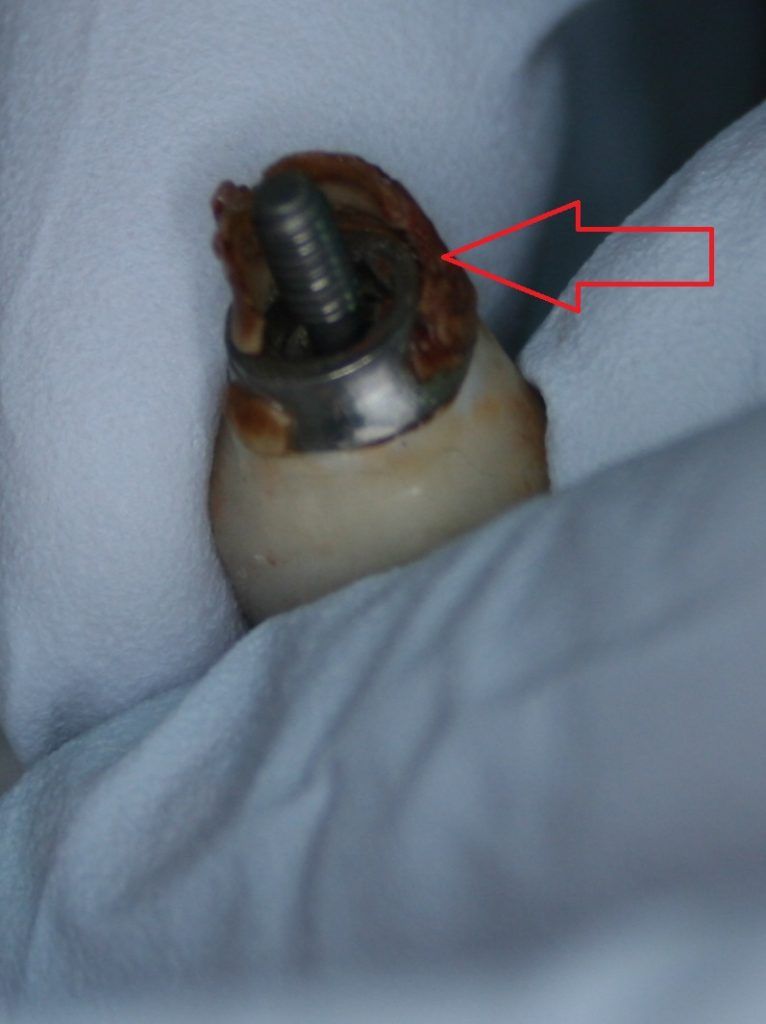
Cement sepsis – What is it?
Cement sepsis is an infection and inflammation caused by dental cement being left around the crown abutment margin. The body doesn’t like the rough surface as it harbors bacteria. Since the body can not expel of it, bone resorbs as an attempt to get away. Left untreated it can cause the dental implant to be lost. Cement sepsis is fairly common. Many dentists have figured out ways to completely avoid this complication and probably never cause this, others well not so much. Dentists are going to see a lot of it if they use stock abutments and poor techniques to cement their dental crowns. If a dentist is going to cement a crown (they can be screw retained), then the steps found on the cement dental crown post should be followed.
Treatment of cement sepsis
Treatment involves removing the dental cement somehow. One might be able to clean if off in a similar manner as teeth are cleaned, but that is unlikely. Usually the cement is deep under the gums and we do not have adequate access to remove the cement. When this is the case, a more invasive procedure is required. The two basic techniques involve making an incision in the gums to gain access or removing the crown to gain access. Don’t worry the crown can usually be saved! If you wold like to know more about the methods to remove cement from around a dental implant click on dental code cement sepsis.
Case example of cement sepsis removal
I feel removing the crown and abutment is fair more consistent and less invasive, so that’s what I usually do. The following case is an example of such. A new patient came to our office with some bone loss and pus around their front dental implant, so an x-ray was taken. The x-ray revealed not just bone loss but cement around the edge of where the crown ended. Unfortunately, this is a clear case of cement sepsis.
There are several issues with trying to identify cement sepsis with x-rays. First off the cement is often radiolucent to the point of being invisible on an x-ray. The second issue is that you can not see the direct front of back at all, due to the metal.
Treatment of cement sepsis case
As I mentioned there are several ways cement sepsis can be addressed. I have found that if the cement is only on the crown and the offending material is removed the body settles down and bone loss is halted. In the posterior more aggressive surgery can be done to help regain bone. In the anterior where the gum levels are esthetcially critical, I try not to cut any gum tissue. The trauma from the surgery alone may have undesirable effects. In this case, although there was bone loss, the tissue levels were good. In order to avoid losing this tissue, I decided to just attempt removal and watch healing.
My main concern with removal was that the access to the screw would be out the front of the crown, necessitating removal of the crown. I could have taken a CBCT and known for sure what the angle was, but my treatment would not have changed. Had the angle been bad the crown would be removed, if not it would be accessed, cleaned, and replaced. I started by drilling into the back side of the crown and fortunately I had straight line access to the screw from this hole.
The above two photos show the cement on the abutment that was causing the cement sepsis. It also shows my access on the lingual to the dental implant. This patient had chipped the porcelain on this crown and a repair was attempted. With the crown removed a much better repair was possible.
This photo shows how the cement is going past where the crown is. Later, the cement was cleaned and crown replaced.
Want to see more cement sepsis?
In conclusion, if you wish to check our more cement sepsis cases and related posts click here.
The post Cement sepsis appeared first on Wheaton Dentist, Orthodontist, Pediatric Dentist.




No comments:
Post a Comment